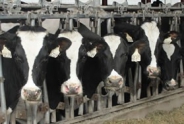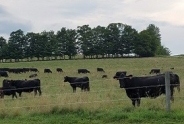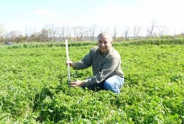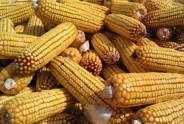Field Crop Update, September 5, 2024
Erik Smith, Area Field Crop Specialist/Team Leader
Central New York Dairy and Field Crops
1. Field Observations and Weather Outlook
Everyone seems to be in the field this week harvesting hay and gearing up for silage harvest. Thank you to everyone who came out to our Dry Down event at Keystone Mills in Fort Plain this past Tuesday! We had about 75 samples, many of which had DMs in the high-20s and low-30s, so a fair number of us still have some waiting to do before corn is ready for silage harvest. The weather over the next 10 days looks great (except for Saturday), so we're expecting lots more hay to be harvested while corn continues to dry down.
When checking the GDD in the next section, remember that GDD from your silking date is what you should be looking at - don't be alarmed or anxious at the high GDD for earlier silking dates. Every field has had a unique growing season, as we all know (especially when taking planting date and hybrid maturity into acct). And while our season-long GDD have been high, we've really cooled off since the middle of summer, such that most locations are at or below the 30-yr avg GDD accumulations since silking. So take your hay now (not a week or two from now) and get your silage when it's ready.
And yes, we still have lots of calendar days left for cover crop planting. Click here for more details, and use the Cover Crop Profiles tab (second from the right in the horizontal black bar near the top of the page) to check out other cover crops to see if they'll work for your situation.
2. Growing Degree Days (GDD) (See: Climate Smart Farming Growing Degree Day Calculator)
The silking dates in section 2 begin July 14th, when I first saw tasseling in the region - so this does not mean that every crop in that particular area tasseled on that earliest date. Your crop may have tasseled on or more closely to one of the later dates. So:
While our GDD tables in section 2 can get you in the ballpark, check your own whole-plant DM to make sure you're ready, and not ahead/behind schedule!
Growing degree days (GDD) are calculated by taking the average daily temperature and subtracting the base temperature for development of a given organism ((High + Low)/2 - base temp = GDD). For corn silage, we are using base 50/86, as corn development starts at 50 degrees F and ceases above 86. Check your location and planting date.
Remember: Silage corn needs 750-800 GDD (depending on hybrid maturity) after silking to reach a whole plant DM of 32%. Under typical late season dry down conditions we can expect the crop to reach 35% DM four to seven days later. We can expect to accumulate 15-25 GDD per day, or even up to 30, so peak maturity can creep up on us quickly. But no matter what the numbers say, always check your crop to see how close you may be to harvest. For more details, see this article.

Blue: Time is make plans (35% DM anywhere between 5-11 days from now, depending on maturity).
Green: Gas up the havester and the trucks (35% DM in 2 - 8 days, depending on maturity).
Yellow: See you in the field (35% DM in less than a week).
Red: It's already in the bunk house or it's going for high-moisture corn or it's goin in the bin for grain (DM likely > 35 - 40%).

Upcoming Events
Labor Roadshow IX
December 1, 2025
December 9 - December 10, 2025December 17 - December 18, 2025December 22, 2025
In-person and online events to keep NY's agricultural employers informed and prepared for today's labor challenges.
Inspired by Annie's: How to Be a Strong Woman Farm Manager
December 10, 2025
December 17, 2025
Free webinars geared towards women who own or operate a farm in NYS.
2026 Dairy Day
January 13, 2026 : Dairy Day - Hamilton
Hamilton, NY
Lunch included
January 14, 2026 : Dairy Day - Ballston Spa
Ballston Spa, NY
Lunch included
Announcements
Statewide Field Crop Pathology Needs Assessment Survey
Your input is wanted for identifying priorities!Sign Up for Our Weekly E-Newsletter
We send out a bi-weekly e-newsletter that has announcements, upcoming programs, and opportunities for you! Registration is quick, easy, and free. Click here to sign up today!Farmers Can Join MeatSuite For Free!
MeatSuite.com is a free resource provided by Cornell University where NY meat farmers can create a farm profile and list their bulk (wholes, halves, quarters) and bundled (i.e. Grilling Bundle) meat products.Why should farmers join?
1. It's free and easy!
2. Connect with more local customers. In the past year the MeatSuite.com farm directory had 8,300 visits from New York consumers. Farm profiles get as many as 25 views per month from potential local customers. We also spotlight MeatSuite farms on social media and bring attention and purchases to farms through highlights and giveaways.
How do I join?
Farmers can visit https://www.meatsuite.com/farmers/ to create a free farm profile. You must list at least one product for your farm's profile to go live. You'll also have access to Cornell's free Meat Price Calculator, a helpful tool for pricing your meat to make a profit.
While you're on MeatSuite, check out the "Creating Consumer-Friendly Bulk Meats" publication on the log-in page. It has tips on how to create bulk meat products that are easier for first-time buyers to say "yes" to.
If you have any questions as you create your farm profile or products, we're here to help! Please email Matt LeRoux at mnl28@cornell.edu.




